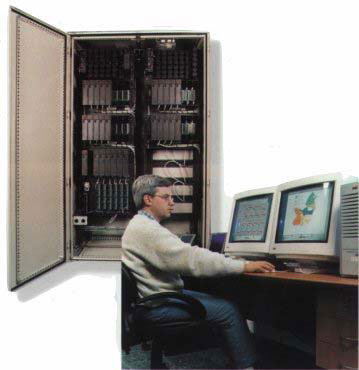 |
 |
| Home | Services | Products | Partners | Documents Library | Contact Us | About Us |
| RTU | SCADA | Software Development | Protocol Implementation | Industrial Design | Internet | |||||||||

What is RTU ?
RTU (Remote Terminal Unit) is a device that enables simple control by sending control signal back to the RTU from the remote location according to the data value. RTU can be modified from the design stage according to the application purpose and can guarantee the real-time response, characteristics of hardware. It can insure safety with size and stable structure suitable for installation location and function. Field instrumentation connected to the plant or equipment being monitored and controlled are interfaced to the Remote Station to allow process manipulation at a remote site. It is also used to gather data from the equipment and transfer them to the central SCADA system. The Remote Station is usually available in two types, namely, the single board and the modular unit. The single board provides a fixed number of input/output (I/O) interfaces. It is cheaper, but does not offer easy expandability to a more sophisticated system. The modular type is an expandable remote station and more expensive than the single board unit. Usually a backplane is used to connect the modules. Any I/O or communication modules needed for future expansion may be easily plugged in on the backplane. Aside from the communications equipment, a SCADA system is characterized by two other elements, the remote terminal units (RTUs) and the master terminal units (MTUs). 
What Does an RTU Do? The RTU gathers information from the field about analog values, alarm and status points, and metered amounts. It keeps this information available in memory until the MTU asks for it. It then codes and transmits the information to the MTU. In addition, when the MTU instructs, the RTU opens and closes valves, turns switches on and off, outputs analog signals that may represent set points, and outputs pulse trains to move stepping motors. This may seem like a rather limited repertoire of functions, but it is sufficient to accomplish all the remote control and monitoring that needs to be done. RTUs are now being offered that have the ability to receive and send messages to field devices in serial format, usually RS-232. In most cases, this feature does not increase SCADA's functionality. however, it does simplify some of the field local data transfer. In the near future, we can expect that serial communications in the form of fieldbus will outnumber the 4-20 mA analog signals used now. At the time this is written, fieldbus is just starting to appear in process control designs. Its advantages, particularly for small systems, are so solid that it will clearly become the protocol of choice for field installations in SCADA systems. Communications Interface Modern RTUs are essentially microcomputers with special equipment at one end that is designed to interface with the communications link and with special equipment at the other end to interface with the sensors, actuators, and calculators in the process. While the RTU is in receive mode, part of the communications interface equipment (the modem) receives a serial signal from the communications medium. This signal is conditioned to a stream of bits that are either ones or zeros. At this stage, the signal is not analog, although some analog signals may have been coded into binary for transmission to the RTU. Using rules that were established when the communications protocol was developed, another part of the communications interface interprets the string of ones and zeros and passes the information on to the rest of the RTU. Note that in some cases the interpretation function is accomplished by the microprocessor that forms the heart of the RTU. When this type of architecture is used, part of the program that translates the ones and zeros into useful information is called a "protocol driver" program. Also, for this architecture, the interrupt feature, which is critical to the operation of an RTU, must execute quickly or there must be a buffer to store the incoming message. If the first bit or bits of a message is not recognized the message is often not understood. The RTU does not know when a message is going to be sent to it. It must always be in the listening mode (except when it is transmitting). However, while it is listening the RTU will be doing many other things. Early RTUs used electronic circuits that were dedicated to listening continuously for incoming messages, decoding them, storing them in buffer memory, and passing pertinent information to the rest of the RTU when the RTU demanded it. Modem RTUs accomplish these functions with the protocol driver program run by the RTU's CPU (central processor unit). |
||||||||||